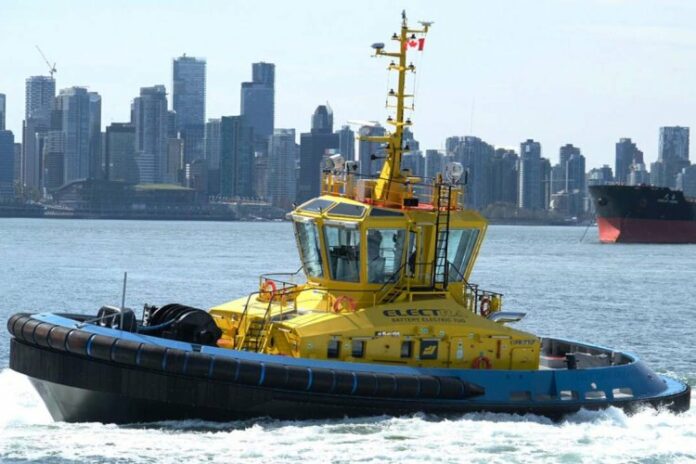Both tugs are owned and operated by SAAM Towage Canada and represent major milestones in the Port of Vancouver’s goal of becoming the world’s most sustainable, as well as SAAM Towage’s leadership in the drive to the decarbonization of harbour operations.
With compact 23 metre lengths and outstanding manoeuvrability, they are perfectly suited for operations between the tight “finger piers” where many ships are docked in Vancouver. They are also ideal for ship-berthing and unberthing work at Neptune terminals in Vancouver where their environmental credentials were instrumental in winning them a contract to provide towage services.
After surveying SAAM’s local Tug Masters, Robert Allan Ltd. embarked on a series of live trials to quantify handling characteristics that these captains identified as most favourable. Using a specialized sensor package, and by closely listening to what the Tug Masters said they could feel, it was possible to establish a quantified baseline for what the new design should ideally achieve.
Predictions of the performance of the new tugs were made using a proprietary CFD-based manoeuvring tool which was validated using the earlier trials. Using this tool, it was possible to establish that the new design, for which underwater features were customized to suit the desired performance, should indeed deliver the specific manoeuvring characteristics that SAAM’s crews had identified as being optimal. The tool was also used to check that directional stability would be on par with expectations. Part of the magic of these tugs is in how this is achieved while also yielding their tremendous manoeuvrability. Hull design is critical to the goal, and one of the other keys is a relatively minimalistic and strategically shaped single skeg that has low drag in all directions, and the benefit of reduced energy consumption in transit.
Sea trials proved that the efforts were a major success. Handling, performance, and manoeuvring characteristics were exactly what had been hoped for, and SAAM was delighted with the results. There is perhaps no greater endorsement of the how these tugs perform than SAAM’s decision very shortly thereafter to order a new ElectRA 2500-SX design (also from Sanmar Shipyards) to operate in Chile. The only caveat was that the existing 25 metre design be updated to have a geometrically similar underwater hull and appendages to the 23 metre tugs/ That work is underway, with delivery of the ElectRA 2500-SX expected in 2025.
The electrical system is powered by a battery installation, which itself sets a new standard for the total capacity that can be installed in a compact tug. Featuring 3,616 kWh of lithium-ion batteries, these tugs pack significant onboard energy storage. That capacity translates into the ability for these relatively high-usage harbour tugs to perform their missions on battery power alone. With charging from the local hydroelectric power grid in as little as one to two hours, these tugs can quickly get out to the next job and accommodate a busy schedule.



